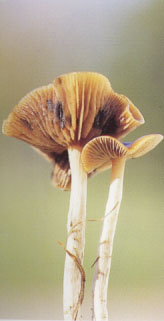- Strophariaceae - North America, Central Europe
 |
Family: Agaricaceae: Strophariaceae; Strophariodeae Tribe, Semilanceata = Cyanescens Section
Genus: Psilocybe
Species: cyanescens
Common Names: blauwwordend kaalkopje (Dutch), blue halos, oink, wavy caps, zauberpilz, zyanescens
Psilocybe cyanescens is most easily identified by its wavy cap, as its most common English-language nickname is derived from this characteristic. Unlike other psilocybin/psilocin-containing mushrooms, this one does not feed on dung, but rather on decomposing forest matter. Wood chips are a very common growth medium for the wavy caps. As the mushroom grows and dwarfs these chips, it often appears as though the mushrooms are growing directly from the forest floor. Although the cyanescens is native to all of North America and central Europe, it growth is most heavily concentrated in the parks of the Pacific Northwest.
While they are rarer in central Europe, varieties found there have a considerably higher concentration of psilocybin and psilocin than their North American counterparts.
TRADITIONAL USE: In central Europe, mushroom cults enact elaborate shamanistic rituals constructed around Psilocybe cyanescens. The first documentation of one of these cults appeared in 1981; that particular cult was seven years old when it was reported on, but it is possible that others began much earlier.
The rituals of these cults involve many traditional trappings and strict regulations, as their goal is consciousness expansion. Perhaps the most common thread amongst the cults is the use of the mushroom in designated areas, usually in beautiful outdoor settings. Other trappings include sweat-bath rituals, pipe ceremonies, fumigations, offerings, prayers, music, and the use of an altar or talking stick (a feature borrowed from North American peyote cults). Some of the rules include avoiding all drugs, sexual contact, meat, and negative thoughts for days before and after the ceremony. Strict fasting also often accompanies the ceremony, as does communal drumming.
These cults are generally influenced by perennial philosophy-based "paganism", and don't view these rituals as "drug" experiences, but rather as a form of "psychedelic shamanism". The Earth Goddess Gaia is as common reference point during the collection and consumption of Psilocybe cyanescens.
Among some of these cults, the Psilocybe cyanescens is used interchangeably with Psilocybe semilanceata.
TRADITIONAL PREPARATION: The preparation of the wavy cap is similar to that of other mushroom that contain psilocybin/psilocin, which is simply to pick them and let them dry. About 1 g dry weight is considered to provide a psychedelic dose.
MEDICINAL USE: Apart from the spiritually/psychologically cleansing aspect of the shamanistic use of this mushroom, it has no known medical use.
TRADITIONAL EFFECTS: As its active components are psilocybin and psilocin, this mushroom provides as similar voyage as others with those same constituents. The effects from mushrooms containing these components can be described as "visionary"; the user may experience personal or external-world insight. Other effects include visual or auditory hallucinations, including deeper appreciation for and an increase in enjoyment of music and visual art. Distinct from other psychedelics, users of mushrooms containing psilocybin and psilocin also have reported a feeling of interconnectedness with the Earth.
http://www.entheology.org/